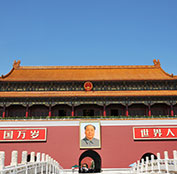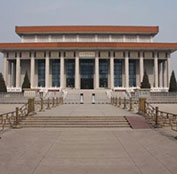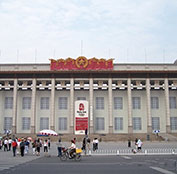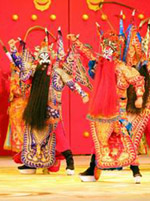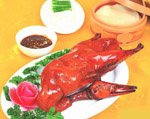Tiananmen Tower
Meridian Gate is the southern gate and the only entrance now to the Forbidden City. Restored in the 17th century, the Meridian Gate is a massive portal that in former times was reserved for the use of the emperor. It has five arches; the three arches are close together while the other two flanking arches are farther apart from the three central arches. Above the arches are five buildings, where the emperor of China reviewed his troops during Ming and Qing dynasties. Its superstructure is also called the “Five Phoenix Turrets”.
(CNY 15 for ascending the Tiananmen Tower; 9:00 am-16:30 pm)
The Monument to the People's Heroes
The Monument is in the center of the Square, commemorates the martyrs who devoted their lives to the Chinese people’s freedom and liberation. Completed in 1958, this 37.9m-high obelisk is the largest monument in the country. The Monument is made of hardy granite and is surrounded by white balusters. Engraved is the epigraph written by Chairman Mao, the founder of People's Republic of China. There are eight sculptures depicting the crucial events which took place in modern times, having shown a part of the centuries-old history of China since 1840.
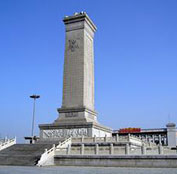
Chairman Mao’s Memorial Hall
The Great Hall of the People, on the western edge of Tiananmen Square, is where the National People’s Congress convenes. It is used for legislative and ceremonial activities. The Great Hall of the People was opened in Sep, 1959. It was one of the “Ten Great Constructions” completed for the 10th Anniversary of the PRC and built in 10 months by volunteers.
(Bag storage CNY 2-10; Camera Storage CNY 2-5; 8:00 am-12:00 Tue-Sun)
Great Hall of the People
The Great Hall of the People, on the western edge of Tiananmen Square, is where the National People’s Congress convenes. It is used for legislative and ceremonial activities. The Great Hall of the People was opened in Sep, 1959. It was one of the “Ten Great Constructions” completed for the 10th Anniversary of the PRC and built in 10 months by volunteers.
(CNY 30, bag deposit CNY 5; 8:30 am-3:00 pm; closed when the National People’s Congress is in session)
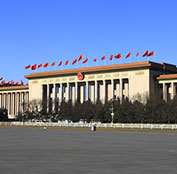
National Museum of China
The National Museum of China flanks the eastern side of Tiananmen Square. The museum’s mission is to educate about the arts and history of China. It was established in 2003 by the merging of the two separate museums that had occupied the same building since 1959. The museum, covering Chinese history from 1.7 million years ago to the end of the Qing Dynasty, has a permanent collection of 1,050,000 items, with many precious and rare artifacts not to be found in museums anywhere else in China or the rest of the world.
(CNY 30; 1:30pm-5:00pm Tue-Fri, 9:30am-5:00pm Sat & Sun)
Qianmen Gate
The gate stands behind Chairman Mao’s Mausoleum at the southern end of Tiananmen Square. It is one of the few remaining Ming-era city gates with more than 600 years old. The gateway consisted of a gatehouse proper and an archery tower, which forms a large barbican. Today the archery tower and the gatehouse survive and it was extensively reconstructed and incorporated modern design elements. Because of its grandeur and unique design, the Qianmen Gate was long seen as the one of the symbols of old Beijing, and it is now also called as National Gate.
Being the front gate of the inner city of Beijing, it lies on the south-north axis of old Beijing city. Straight south from the gate along the old Imperial Way is the Temple of Heaven, where the emperors made annual sacrifices to Heaven. Qianmen Avenue was once the route-of-choice for ancient Chinese emperors who traversed the street on their way to the Temple of Heaven. Qianmen area was, in essence, the heart of old Beijing. The area has been redesigned and rebuilt as a Beijing history-themed shopping and dining area.

Subway: Take Line 1 to Tiananmen Dong (East) or Tiananmen Xi (West) Station
Take Line 2 to Qianmen Station - Exit A/B - walk north
Bus: Tiananmen Xi Station: Bus 1, 5, 10, 37, 52, 90, 99, 205, 728, Special Line 1/2
Tiananmen Dong Station: Bus 1, 2, 10, 37, 52, 59, 82, 90, 99, 120, 126, 203, 205, 210, 728, Zhuan 1/2
Tiananmen Guangchang Dong/Xi Station (Tiananmen Square East/West): 2, 5, 120, 126, Zhuan 1/2
